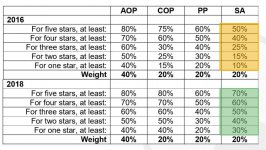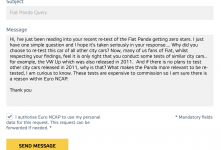TL;DR: the new test takes mostly moot points and applies them to the argument nobody is making in the first place (taking a 7 year old car and applying new, inapplicable standards to a use-case that rarely exists).
Semantically speaking, the Panda is no less safe than it was when it was first produced and tested since the vehicle hasn't changed. What has changed is what is considered 'safe'.
The emphasis on electronic driving aids is a double edged sword, because it's actually a numbers game. If auto emergency braking, for example, reduces the probability of an accident (which it statistically does), it is deemed worth the effort of implementing. This, in turn, introduces an element of reliance on that technology (in other words a reduction in driving attentiveness) which may or may not have been a factor in the probable accident in the first place. The fact that we can't know for sure means that it's mathematically sound to have such technology. As a counterexample of a similar situation, even the most attentive driver doing 5 below the inner city speed limit won't be able to account for dumb little children with no concept of mass, force, stopping distance etc. who's parents have not yet instilled a fear for life by properly teaching pedestrian safety. These kids (who are usually just around visible height from a driving position) will dash out from in between parked cars at any point in the road without looking anywhere and no amount of driving prowess, attention or auto emergency city braking can do anything about that impact. That's where pedestrian safety standards come into play, because as much as we love our children, they're little bags of meat and bones just like us, but with less awareness and little to no notion of consequence. This is usually the thinking behind pedestrian safety standards, and the statistics to justify it are actually more about drivers failing to yield to pedestrian right-of-way points such as junctions and crossings (so the math tells us it's usually the drivers doing the hitting rather than the pedestrians doing the walking in front of cars).
Lastly, as many on the forum know, fitting a child seat to the rear of the Panda is a faff. Fitting a pram into the boot is also a faff, especially as prams and baby carriages and seats get larger (ironically also usually for safety). If you've ever tried to fold and fit a newer model of a baby carriage into the boot of the Panda, then tried to use the carriage section to move the child into the back seat using the isoFix mounts, you'll know that two things happen: First, the damn thing either won't or will barely fit into the boot leaving no room for the baby bag, which you have to move to the rear seat (which is an accident hazard as it's unsecured cargo). Then you spend a good half minute with the door open trying to secure the seat to the mounts, during which the child gets irritated and starts complaining. This results in the inability to make any swift progress with a child, as setting off in the first place becomes an ordeal. This situation is not unique to the Panda, and is a common issue on many small city cars, which is why they are called 'small city car' and not 'family car' or some other nomenclature that would indicate otherwise. In turn, one of the first things who own city cars do when they have a child is to get a bigger vehicle. By the time the child is 7-10 years old (the age at which the dummies in the test represent), most people who haven't moved to a larger vehicle have felt the need to do so for some time as not only has the little human grown in size, but so has the size of and amount of things they tend to require (such as the introduction of backpacks, sports equipment, school projects, multiple friends of various denominations of length and girth). Sure, living with a Panda with offspring is 'doable', just as wearing shoes a half size too small is 'doable'. The Panda will do it all, just not as good as it could (or should), and the shoe will still protect your feet but at the end of the day you'll wonder whether it was worth the cost.
So, as you can probably deduce, the electronics and pedestrian emphasis on the test is as much political and legislative as it is awkward. In the United States, the rising belt line on newer vehicles (for side impact safety, ironically) and the introduction of rollover testing has resulted in vehicles you simply can't see out the back of, which resulted in children getting run over by their parents as they back out of the garage or driveway. Someone showed some politicians a few numbers, and now all new cars sold in America are required to have a back up camera from 2019 onward. Basically, a solution to a problem that was created by a solution to another problem has been driven by skewed mathematics and a poor understanding of systems design/process management. I won't be surprised if electronic aids become legally required around the world in the near future, and even if they currently aren't, the public perception created by the aforementioned skewed statistics means that manufacturers will have to follow suit whether they are legally required to or not. The other key area in which the Panda has been deemed 'less safe than before' is a point with little real-world consequence to most Panda owners, unless they enjoy the torture of using a small city car as a people-mover, in which case they would be no better off in pretty much any other city car for the most part.




